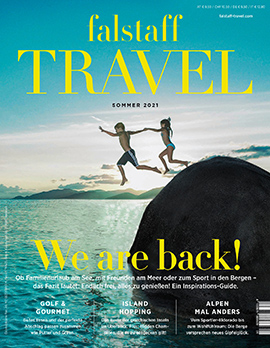
Scotland: A Favorite Autumn Destination
Steep cliffs, lapped by the rough Atlantic, stories of heroes and Highlands, leprechauns and Nessie, told to bagpipe music and a glass of whisky, the essence of the Scottish soul: the breathtakingly beautiful and diverse country in the north of Britain will immediately fascinate you.
November 5, 2024
© Getty Images
Some places in this world touch travelers on a deep, almost irrational level – as if you're falling in love with them. Scotland, the myth-laden land battered by the Atlantic, at times seemingly dangerous yet overall reminiscent of a safe haven, has this effect on most people. Wild and gentle, modern yet delightfully steeped in the past, it’s a place where you can take a break from the hustle and bustle of European cities.
A room at the Rucksacks St Andrews Hotel © beigestellt
Most visitors start their journey in Edinburgh, the capital of Scotland since the 15th century. After Glasgow, it’s the country’s second-largest city, home to 525,000 people. Poets refer to this city as the "Athens of the North," and the writer Robert Louis Stevenson even said, "Edinburgh is what Paris should be." As someone born here, Stevenson’s statement may be a bit biased, but the city’s beauty is undeniable: It sits atop seven hills, crowned by the majestic silhouette of Edinburgh Castle. Built on an extinct volcano, this castle is the heart of the city. From the top, you can enjoy wonderful views—and if you want to feel like you're in a historical drama, take a stroll along the Royal Mile, which connects the castle with Holyrood Palace, where you'll be passing medieval and elegant Georgian taverns along the way.
Highlights in the Highlands



From Edinburgh, the journey continues northward, where the rugged Highlands offer one breathtaking natural wonder after another. There’s Loch Ness, likely the world’s most famous lake—if you gaze long enough into its inky black waters and have enough Highland spirit (whisky) in you, you might even catch a glimpse of Nessie. Ancient castle ruins, such as Urquhart Castle, picturesque villages, and vast valleys shape the landscape here. Scottish history, filled with tales of heroism, is palpable at every turn: for instance, Glencoe Valley, now a stunning landscape surrounded by steep mountain slopes and clear streams, witnessed a massacre in the 17th century, one of the darkest chapters in Scottish history. This area also contains the site of James Bond's family estate, which the agent returned to in Skyfall (2012, portrayed by Daniel Craig). Fans will most likely recognize the “Three Sisters” mountains, or Eilean Donan Castle. Towering over it all, you'll see Ben Nevis, Scotland’s and Great Britain’s highest mountain at 1,345 meters. It’s the ultimate goal for anyone tackling the famous 154-kilometer West Highland Way. A trip to the Glenfinnan Viaduct is also a must—the railway bridge became world-famous as the filming location for the Hogwarts Express in the Harry Potter movies.
The iconic Glenfinnan Viaduct © Getty Images
Another famous bridge lies farther west, connecting the Scottish mainland with the Isle of Skye. Framed by dramatic mountain ranges like the Cuillin Hills and rugged coastlines, this island is home to picturesque villages and iconic sights such as the rock formation known as the Old Man of Storr. It’s no surprise that heroic dramas like Highlander were filmed on the Isle of Skye.
The bar of the iconic Rocco Forte hotel The Balmoral © beigestellt
Here, you'll also find some of the world’s most famous whisky distilleries, such as Talisker. They offer tours of their production facilities, tastings, and, conveniently, an on-site shop. A visit to Scotland wouldn’t be complete without a tour of a whisky distillery—or, to quote Mark Twain, “Too much of anything is bad, but too much good whisky is barely enough.” Whisky is more than just a drink here; it’s the “water of life” and an experience deeply rooted in Scottish culture.
Gourmets and Glasgow
The Michelin-awarded cuisine at Cail Bruich© provided
At least as well-known as whisky, but far less often tasted, is Scotland’s national dish: haggis. It tastes all the better if you’re not too aware that it consists of sheep’s stomach stuffed with sheep heart, liver, lung, and suet, along with oatmeal, onions, and barley. Traditionally served with “neeps and tatties” (turnips and potatoes), sheep-in-sheep is surprisingly tasty and quite hearty. Dishes like this make it hard to believe that Scotland has recently become a gourmet hotspot—but in fact, Glasgow and Edinburgh are now home to eleven restaurants boasting a total of thirteen Michelin stars, alongside plenty of excellent pubs, restaurants, and inns.



Beyond its culinary delights, Glasgow also offers plenty of history. You only need to go on a stroll to feel it, but attractions like the free-entry Kelvingrove Art Gallery & Museum go even further, bringing history to life. As Scotland’s largest city, Glasgow is known as a creative hub and a vibrant center for art, culture, and architecture. Modern galleries, numerous high-end shops and boutiques, and noteworthy sights make the city much more than just the starting point for the legendary West Highland Way. Notable landmarks include the magnificent medieval Glasgow Cathedral, the Glasgow Necropolis—a Victorian cemetery—and the Glasgow Science Centre, offering insights into science and technology.
If you're in the mood to shop, Buchanan Street is the place to be. It’s considered the best shopping street in the United Kingdom outside of London, offering everything from men’s fashion and kilts at Hector Russell to designer brands at House of Fraser, featuring names from Armani to Valentino. In this regard, Scotland truly is a land of contrasts as well.

This article appeared in the Falstaff TRAVEL issue Fall 2024.






